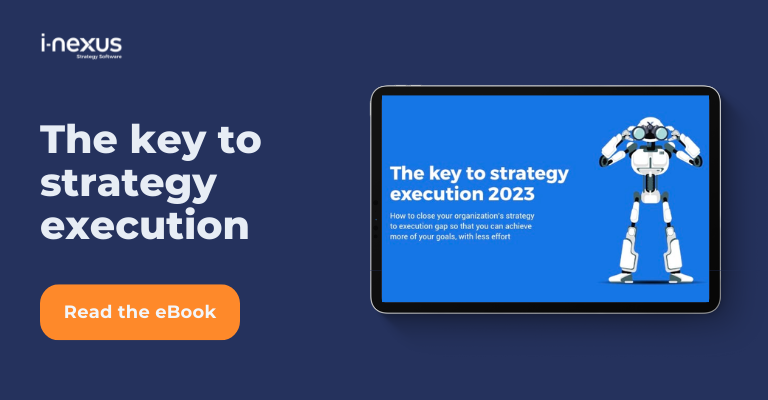Why do 40% of transformations fail to reach their goals? Is it because of the team or the individual? Here are 13 ways you can promote individual accountability for your strategic goals.
Written by: James Milsom, Head of Marketing
“The whole is greater than the sum of its parts.”
Aristotle
We can look to many reasons for why strategic transformations fail, or at least fail in in their intentions.
Whether it’s unattainable goals (or the inverse), lack of resources or simply market conditions outpacing the organization’s ability to pivot, we can spend great effort in questioning our failures.
But what if the issue was not the aforementioned? What if the problem lay with how your individuals and the teams they form were unfocused, with accountability left wanting?
If the coxswain orders the rowers to row in one direction and only half the boat follows suit, the boat fails to achieve its goals of forward motion.
If the quarterback ignores the offensive coordinator’s call for a passing play and hands off to the halfback, with wide-receivers set in motion, this dramatically reduces the team’s ability to make it down the field in their drive.
There are many metaphors that can be employed, but the conclusion we reach is accountability is at the core of team-based success. And, after all, your organization is a team.
Indeed, there are parts who have responsibilities, but they come together for the sum, and if the sum cannot realize its purpose (goals), it will fail.
Today we’re exploring three different dimensions for inspiring accountability for strategic goals – through the eyes of a leader, a manager and a team member. Read on to discover why every individual has a role to play in your transformation’s success, and the common thread is holding one’s self to account.
For leaders
1. Delegate
Micro-managing, closed-off to outside views, limited opportunities for growth and participation – these are all the qualities of an autocrat.
In days gone this form of leadership may have been an option for the generations coming out of wars across the globe, but in 2021 our workforce has more options to work, spurred on by COVID-19’s promotion of remote working, and we, as a people, want to feel fulfilled from our employment.
It stands to reason then that accountability for strategic goals will live and die by a leader’s ability to delegate tasks and responsibilities to their management team.
Delegation is central to the make-up of a stalwart leader, and means that you can connect your management team to your vision of the strategy, ensuring the cascade of goals to their teams are done so with clarity of purpose.
2. Provide the right tools
What is a tennis player without a racket? The 100m sprinter without a stopwatch to measure their time?
As a leader it is your responsibility to ensure that the business has the correct tools to execute your strategy.
Whether that is a licence for Microsoft Office, Zoom, pens, paper or Strategy Execution Management software, you absolutely must give your managers and their staff the resource they need.
And if you are unsure of what is needed, ask your management team or survey the organization to see what recommendations appear.
3. Lead by example
Lastly, do not be afraid to lead by example.
Perhaps you cannot do the work of the individuals working on your improvement priorities, but you absolutely can be seen to be involved in kaizen events, participating in countermeasure events, or completing a gemba walk.
Do not believe that your team cannot benefit from your presence in their daily work (but do not overstay your welcome). Your encouragement and investment in their efforts will inspire great results.
For managers
1. Involve team members in goal setting
Management teams are responsible for taking the leaders’ strategic view and building out the projects which will support the core targets to improve.
But how can those projects and their associated goals, and indeed the top line improvement priorities, be created without involving the teams who will execute the plan?
That is why the catchball technique is so valuable.
Knowledge holders walk the workshop floor, they sit in kaizen workshops, they’re present on every Zoom call. Use the wisdom that surrounds you to breathe creativity and a new way of approaching work which will support the step change that has been targeted by your leaders.
2. Managers should support each other
Transformation cannot fall prey to tribalism.
Departmental siloes must fall to the wayside. The critical thinking involved with transformation necessitates identifying the resource which will be needed to make this breakthrough change a reality.
The decision on human resource involved in transformation can breed conflict between managers where team members are pulled from operational activity to support in the long-term effort of your strategic program.
Work with your fellow managers who are affected to offer support, where possible, and in general build a network to ensure that you are demonstrating how your teams should interact.
Break down the walls.
3. Track your team’s performance and contribution
If you are managing a team responsible for a project that supports an improvement priority, you must hold yourself accountable in terms of tracking how your team is performing and contributing to overall progression.
That does not mean micro-managing, however.
Make use of systems which allow your team to enter metrics and accompanying journals for the tasks that make up your projects.
Hold regular reviews of the team’s performance and utilize traffic light systems and analytical software, such as i-nexus Advisor, to identify any trends.
4. Build and inspire
Accountability can come from a sense of belonging.
Ensure you create team building workshops, keep the lines of communication open upwards and across the team. Whether it is communication about work or our personal lives, the greater the bond we feel to our colleagues, the more likely we are to put in more effort to achieve our goals as a unit.
And remember, much like leaders should be seen to be involved in the process, so too should managers. Run a kaizen event, celebrate the successes and, crucially, learn from the failures…
5. Try again, fail again, fail better
Samuel Beckett couldn’t have said it better.
You must allow your team to fail.
Inspire, manage, build cohesion, but do not create an artificial environment where failure is not a consequence.
For all the best endeavours and meticulous preparation for success, we still fail.
That’s why it is important to hold yourself accountable for giving the team root cause analysis tools and the support to analyze why they may have failed, and the power to correct that.
If you shield your team from unfruitful efforts, you’re doing them a disservice.
For team members
1. Journal
There is no doubting that being part of a transformation program is a signal that your talents are valued, but it is a doubled edged sword given the personal change that will come with this period.
Your workload will vary in intensity and volume, and that’s why it is important to complete goal journals alongside any metrics you enter. A goal journal will provide a story behind the number – perhaps other tasks impacted your execution, your motivation levels were low, or focusing was difficult due to your overall mood.
Too often we ignore our psychological signals, but by giving this insight into your efforts you can reflect in the future about the factors impacting your work.
2. Support a colleague when they struggle
Continuing with the first accountability suggestion, mental health is paramount, so please do support a colleague when they appear to be struggling.
Accountability within your team isn’t simply tracking your own thoughts, feelings and efforts. If you notice a dip in your colleagues, offer support – whether that is a coffee, training or simply listening, it is in everyone’s interests to be conscientious of our teammates
3. Schedule your work
In a transformation program you will typically be pulled across multiple projects.
Your managers and their leaders will be able to see the interdependencies through tools such as the x-matrix, but that is at a top-level view.
By planning out your work load you can give transparency of your efforts and give your manager more data to understand where the resource is being employed.
Moreover, if you know when your work should be completed, you are setting micro-goals, another tool to drive your execution.
4. Self-review
As your manager and leadership seeks the correct tools to allow you to perform to the expected levels, one necessity to promote accountability is a goal tracking app.
Tools such as i-nexus Pulse allow you to enter metrics and complete accompanying journals in-situ, meaning you can focus more on your work and less on data entry.
The invaluable end product is the data you are entering is directly deposited into the central Strategy Execution Management platform.
With the right provider of such software you can receive regular review emails to let you self-critique your performance.
Much like you would use an app like MyFitnessPal to enter metrics on your food, height, weight and other measurements and regularly review your progress, platforms like i-nexus give you automated reports to track your own efforts.
There is little that can provide motivation more so than self-review. When we actively review our performance this can provide incredible motivation to improve.
Self-review to stay accountable to your goals.
5. Ask for help
Finally, do not shy away from asking for help.
There is no shame in wanting support or training to improve your efforts.
Lack of understanding or ability is what can lead to goal slippage.
Holding yourself accountable for strategic goals means cooperation.
Leverage the expertise of the team around you to improve your own abilities. It is better to ask for help than it is to actively know you won’t be able to complete your work and, ultimately, be a reason for your team’s failure.
Is any one person accountable?
In short, no
Organizational layers, line reports and different roles exist for a reason, and that is to build a network of support, knowledge and responsibility to keep the business moving and serving its customers.
Strategic goal setting and the execution of our strategy is vital to the success of our organization. It incorporates incredible changes in our behaviors, our way of working and, crucially, how we hold ourselves accountable.
Indeed, regular road shows and reports on performance act as a means to whip businesses into action, but being proactive is much better than being reactive.
To stay ahead of ourselves and on-course for realizing the benefits of our strategic goals we must acknowledge that every one of us is responsible for the success and failure of the transformation program.
When the one percent combines, holding itself for its part in the transformation, the whole succeeds, and after all, it is the whole which is greater than the sum of its parts.
Continue learning about Strategy Execution Management
Click here to visit our Strategy Execution Management knowledge hub, filled with content to support you in embracing the 'no normal' of strategy in the 2020s and beyond, or explore these recommendations:
- Strat to Action – Developing a countermeasure culture: Watch our on-demand presentation of how you can guide your business towards using data and countermeasures to drive strategic success.
- Adaptive Strategy - the future of delivering strategic value at pace?: Watch our latest webinar addressing the future of strategic planning, program deployment and portfolio optimization for value delivery at pace.
- Download our Key to Strategy Execution eBook: Read how companies like Danaher and HP have mastered Strategy Execution Management and what you can learn from them.
About the author
James Milsom is Head of Marketing at i-nexus. James has wide-ranging experience of markets such as telecommunications, energy, education and software.
As Head of Marketing, his drive is to raise awareness and understanding of the challenges facing enterprises in delivering strategic objectives and transformation amidst changing markets and the obstacles traditional tools and methods present leaders.
If you’d like to talk more about Strategy Execution, reach out to James on james.milsom@i-nexus.com or connect with him on LinkedIn for the latest insights.



